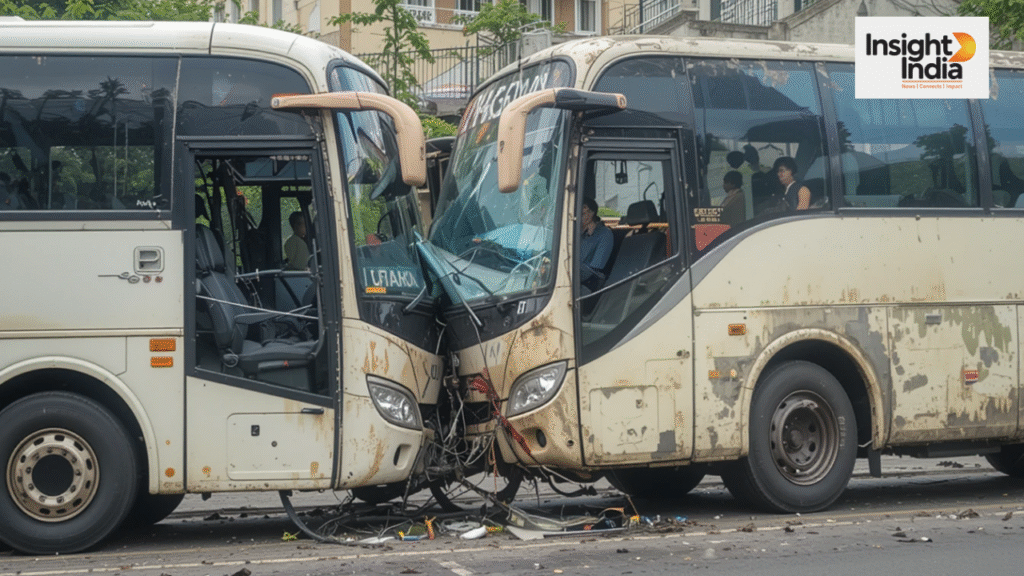Lucknow Sleeper Bus Accident: A sleeper bus from Bihar to UP caught fire early Thursday in Lucknow, killing five people, including two children. The tragic incident raises serious concerns about the safety of sleeper buses and why they often turn into deadly traps for passengers.

Lucknow Sleeper Bus Accident Kills: Why These Buses Often Turn Deadly
New Delhi: A tragic accident occurred in Lucknow when a sleeper bus traveling from Bihar to Delhi suddenly caught fire. Five people, including two children, lost their lives after being trapped in the flames. At the time of the incident, most passengers were asleep. The driver and conductor managed to escape by jumping off the moving bus. According to eyewitnesses, the burning bus continued to move for about a kilometer, causing chaos among the passengers.
Some passengers tried to rush toward the doors, while others broke windows in an attempt to escape. However, the emergency exit didn’t open, which made the situation even more dangerous. This raises a serious question: Why do sleeper buses often become moving coffins in such accidents? What are the safety flaws? Let’s understand.
Drivers Lose Control Due to Drowsiness
A report by the Ministry of Road Transport reveals that road accidents caused by drivers losing control increased by over 5% in 2022. Around 9,862 people died due to such accidents, and the numbers are believed to be even higher now. These incidents mostly happen in the early morning hours, just like this bus tragedy in Lucknow. The ministry categorizes such cases under “run-off-the-road” accidents, where vehicles go off course, sometimes falling into valleys in hilly areas.
Highway Design Adds to the Problem
Experts say most highways in India are straight with very few curves or visual changes, which can make drivers feel bored or sleepy. This leads to a higher chance of accidents. Some transporters believe that the government should first lower the speed limits and only increase them gradually once accident rates decline. There is also a demand for proper studies of highways to improve their safety design.
Sleeper Buses Have Poor Space and Safety Access
Most sleeper buses have bunks that are about six feet long and 2.6 feet wide. While they allow passengers to lie down, there’s very little space to move around. In emergencies like fire, passengers often get stuck as they cannot easily move or exit. The emergency doors are hard to reach, especially when the bus tilts or fills with smoke.
Moreover, the height of these buses, typically 8 to 9 feet, makes it even harder for passengers to access the emergency exits during accidents. This also creates challenges for rescue workers, who must climb to that height to help people escape.

Overworked Drivers and Lack of Alert Systems
Many private sleeper bus drivers cover distances of 800 to 1000 kilometers in a single trip, leading to extreme fatigue. Unfortunately, these buses usually don’t have drowsiness alert systems that could notify drivers if they are falling asleep. Such systems use sensors on the steering wheel, dashboard cameras, and other monitoring tools to detect unusual driver behavior.
Sleeper Buses Banned in China, Not in India
After a deadly sleeper bus fire in August 2012, China banned the registration of new sleeper buses, although older ones were allowed to operate. In that year alone, at least three major sleeper bus accidents killed 62 people and injured 67 others. Before the ban, China had over 37,000 sleeper buses. Today, only India and Pakistan operate a large number of such vehicles.
China also banned sleeper buses from operating between 2 AM and 5 AM due to increased accidents during that time. In 2011, a fire on a sleeper bus killed 41 people, prompting the government to issue safety guidelines requiring drivers to rest during high-risk hours.
25% of Drivers Admit Falling Asleep at the Wheel
In a 2018 survey by the Ministry of Road Transport, 25% of long-route drivers admitted that they had fallen asleep while driving. Studies show this risk increases on highways and rural roads, especially between 2 and 5 in the morning.
Sleeping Passengers Often Don’t Survive
One reason sleeper bus accidents lead to high casualties is that most passengers are asleep during such incidents. Awake passengers can react quickly, but those asleep lose precious moments. Many bunks are closed from the top, making it harder for passengers to notice fires until it’s too late.
Private Bus Operators Often Ignore Safety Norms
Most private sleeper bus drivers are either under-trained or untrained. These buses often operate at high speeds on highways with little regard for speed limits. Some drivers are not even taught how to handle speeds of 100-120 km/h, which is common on Indian highways.
Experts recommend that drivers should first prove their capability to handle such speeds before operating long-distance buses. There is also a call to enforce stricter safety training and speed controls on highways.
Design and Safety Standards Are Missing
A key concern is whether sleeper buses are even built according to proper safety standards. As more people choose sleeper buses for travel, accident rates have also gone up. Road safety experts point out two major issues: poor bus design and a lack of emergency response mechanisms. In most cases, there are no proper systems in place to rescue passengers in case of fire or other emergencies.
The Lucknow incident is a painful reminder of the growing need to prioritize safety in India’s bus transport system, especially for sleeper coaches. Without strong regulations and accountability, such tragedies are likely to continue.
Also Read:
- President Asks 14 Questions: Can SC Set Deadline for Bills?
- Mumbai Indians vs Delhi Capitals match scorecard: MI Beats DC to Seal Playoff Spot
Author

Aditya
Aditya is a dedicated writer at InsightIndia.in, covering the latest news from across India with a focus on results and public updates. With a strong eye for accuracy and clarity, he brings timely information to readers, helping them stay informed about key developments and outcomes that matter.



















